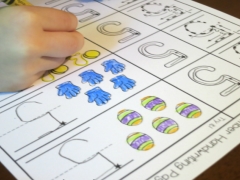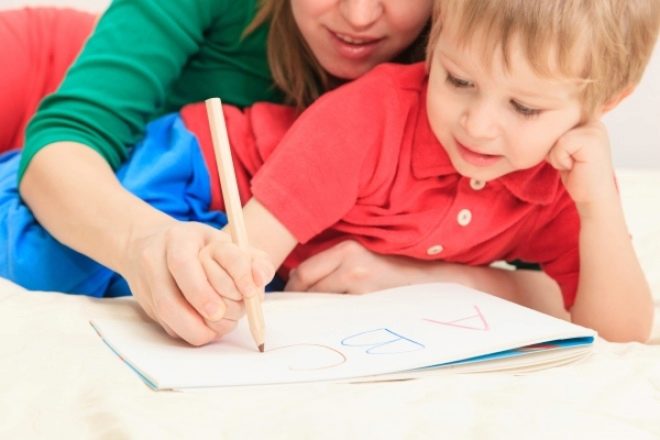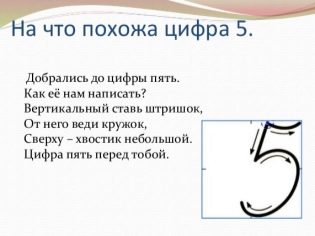Teach your child to write the number 5
Teaching a kid to write is not easy and requires a lot of patience from parents. There is a risk that the child will show absolutely no interest in this activity and, as a result, he will hate the letter if the senior mentors put excessive pressure on him.
Therefore, you should responsibly refer to the recommendations about the appropriate age for learning, interesting methods, techniques, games, writing, etc.
When should I start my studies?
At the age of three or four years, the child is very mobile, it will be difficult to seat him at the desk and make him display numbers and letters. During this period, children are usually restless, they want to run, play. And even if you manage to teach a child to write a single letter or number, there is a risk that he will never find good handwriting.
If the baby is not interested in the activity, he will do his best to avoid it or to go through this stage and continue to do what he likes. In particular, if the written signs are not interesting to him, there is not enough motivation, no curiosity and no desire to discover something new in this area, he will do the work mechanically, quickly, carelessly. For you to fall behind, but not for yourself. This is how an inaccurate handwriting will be formed, which to correct will be presented as a difficult task.
The best age is 5-6 years. In kindergarten, at this stage, children are already starting to prepare for school, explaining the significance of writing and reading skills. They wake up competitive spirit - I want to read and write better than others. You just have to help them in this.
But do not teach the child before the school all the numbers and letters. In the first grade, they should not lose interest, and if they know everything that they are doing in class, the motivation to attend these lessons will quickly disappear.
How to prepare a preschooler to the letter?
It is necessary to prepare the child for the letter at preschool age. This should be done unobtrusively, enticing him, not forcing him. It is necessary to develop fine motor skills of hands. There are many ways, choose those that will interest the child. Do not focus on one, alternate:
- You can make applications from different materials (leaves, paper, grains, cereals, etc.).
- Teach your kid to cut figurines of varying difficulty from paper.
- Paper modeling is a good exercise.
- Engage in finger gymnastics.
- Teach to sculpt from clay, clay, dough.
- You can try beading.
- Use constructor, mosaic, puzzles.
- Drawing, coloring - what exactly interested preschool child.
- You can buy several books. For preschool children there are tasks in which you need to circle the figure by points.
Whatever task you undertake, do not rush the child, do not show that you are upset by his failures.
In training, mistakes cannot be avoided, and let your child not be afraid to make them.
What to look for?
During your classes, the explanation should be clear to the preschooler, and the form of presentation should be fun, you can play. At the same time, he should learn to write with your positive reinforcement. To teach a small child at least something, cursing him, will not work. You need to constantly praise even the smallest successes.
It should start with simple tasks, gradually moving to difficult ones. If the kid understands at the initial stage of learning that he is failing, he will give up, wants to stop classes. Do about 20 minutes a day. More child will not be able to concentrate and will be distracted.
Learning numbers
You can study the number “five” in different ways:
- Examine with the baby its appearance. Let him tell you what she looks like. You can pre-select illustrations, puzzles, riddles. The more original the answers, the better. You can tell an interesting story about this figure, and come up with its end to offer the crumbs.
- Use tactile sensations. Let the baby touch the number five. Cut it out of cardboard or buy plastic. Well, if the child remembers its shape.
- Invite the young researcher to blind five of clay.
- Stock up with colorings with numbers. The child can paint over or shade the number 5.
- Ask your child about the number under study at any time. Let him find it among the price tags in the store, on the dial, in the book, on the ruler, in the calendar.
- You can use associations. Link the number five to something. Perhaps one of the family members has his birthday on the fifth day or the baby is five years old, or is the fifth month of the year. Connect the imagination.
Correct writing
Before starting to write, let the kid practice to add a number from separate elements. You can make these elements yourself (two sticks and an oval), you can use the available tools. For example, the number five can be laid out with buttons, candy, clips, coins, etc.
Next, the child must study the notebook cell, the location of its elements. He must understand where the upper and lower sides are, the right and left borders, the middle, the corners.
Before writing numbers, a preschooler should be trained to draw sticks, lines, ovals, semicircles - those elements that make up the whole number.
It is important to teach your child to observe the angle of inclination when writing numbers. You also need to explain that the figure occupies almost the entire cell, but does not go beyond its boundaries. Before writing the top five, the child should practice drawing the points, resulting in this figure.
Now directly on how to write the number 5:
- We put a point on the upper border of the cell just to the right of its middle. We carry the wand tilted down to the left, reaching the center of the cage.
- Next, we draw a semi-oval, rounding it up, then to the right, gradually sinking down (it should touch the right side of the cage). Then round the oval, touching the lower border, we rise and stop just above it.
- We tear off the pen from the paper, return to the starting point and draw a small tail with a small bend. Bring it to the top right corner of the cell.
One number must be repeated several times in the line. The pre-baby must get used to, gradually moving to what we call "writing on the machine". Let him rest, draw near suns, hearts, if he wants. If only the kid did not like to learn to write.
See how to write numbers in the next video.






































